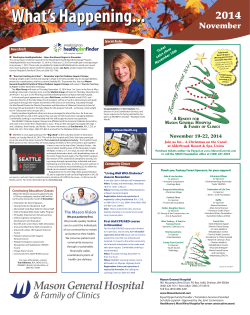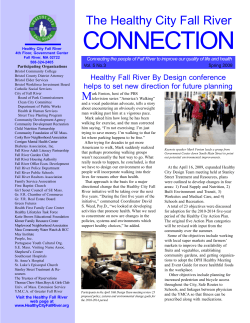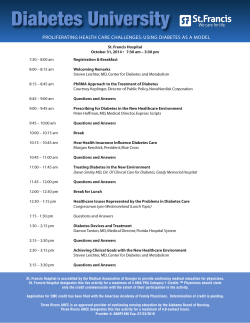
PDF - Herbert Publications
Journal of Diabetes Research & Clinical Metabolism ISSN 2050-0866 | Volume 3 | Article 10 Special Section | Diabetic Complications | Original Open Access Efficacy and safety of sitagliptin as a third therapeutic agent in the treatment of type 2 diabetes mellitus Fatemeh Hayati1, Amjed Hazim2, Teguh Haryo Sasongko1, Gan Siew Hua1, Wan Mohd Izani Wan Mohamed3, Juhaida Daud4, Nik Soriani Yaacob2 and Wan Mohamad Wan Bebakar3* *Correspondence: wanmohd@usm.my CrossMark ← Click for updates Human Genome Center, School of Medical Science Universiti Sains Malaysia, 16150 Kubang Kerian, Kota Bharu, Kelantan, Malaysia. Department of Chemical Pathology, School of Medical Science Universiti Sains Malaysia, 16150 Kubang Kerian, Kota Bharu, Kelantan, Malaysia. 3 Department of Medicine, School of Medical Science Universiti Sains Malaysia, 16150 Kubang Kerian, Kota Bharu, Kelantan, Malaysia. 4 Family Medicine Clinic, School of Medical Science Universiti Sains Malaysia, 16150 Kubang Kerian, Kota Bharu, Kelantan, Malaysia. 1 2 Abstract Background: Information on sitagliptin as a third line agent in combination with other antidiabetic agents is still lacking. This study evaluated the safety and efficacy of sitagliptin as an add-on therapyin type 2 diabetes mellitus (T2DM) patients with poorly controlled glucose control despite receiving an optimum dose ofmetforminand sulphonylurea. Method: In a 24-week, non-randomized, open-labeled trial study, T2DM patients (n=93) who were on optimum dosage of metformin and sulphonylurea were additionally treated with 100 mg sitagliptin daily. Primary efficacy end point was assessed by investigating the changes in hemoglobin A1C (HbA1c) and a secondary efficacy end point was assessed by fasting plasma glucose (FPG). Safety was assessed by recording of hypoglycemia, change in body mass index (BMI), blood pressure, lipid profiles high density lipoprotein (HDL), low density lipoprotein (LDL), total cholesterol (Tc) and triglycerides, serum aspartate aminotransferase (AST), alanine transaminase (ALT), alkaline phosphatase (ALP), urea, uric acid and creatinine levels. Result: The mean HbA1c was reduced by 0.41% (P<0.007), and overall, 18.27% of patients achieved an HbA1c goal of <7%. After 6 months. ALP was reduced by 5.23 (P=0.035) and uric acid was increased by 16.20μmol/l (P=0.048) respectively. There was no significant change in LDL, Tc, triglycerides, FPG, BMI, blood pressure, urea, AST and ALT. Hypoglycemia was observed only in a small percentage (2.65%) of patients. Although uric acid levels were slightly increased in this study, they were still within the normal range. Conclusion: Sitagliptin is effective and safe to be used in combination with metformin and sulphonylurea therapies. Keywords: Diabetes, dipeptidyl peptidase 4 inhibitors, sitagliptin, HbA1c Introduction Ensuring optimal efficacy of the drug in mono- or combination Improvement in glucose control is the most important thera- therapies during clinical trials is of paramount importance to peutic approach in primary prevention of diabetic complications. ensure the safety of patients while giving minimal adverse effects. To date, several oral anti-hyperglycemic drugs are available There are different classes of anti-diabetic drugs, the selection of to induce glucose level to near normalcy. Evidence from the which is dependent on the type of diabetes, patients and drug literature has demonstrated that a high percentage (60%) of characteristics [2]. Thiazolidinedione, glinides, sulphonylurea, patients do not achieve glycemic targets due to the progressive pramlinitide, metformin and glucagon-like peptide-1 agonists nature of type 2 diabetes (T2DM) making combination therapy (GLP-1) are beneficial in lowering hemoglobin A1C (HbA1c) for optimal glycemic control a necessity [1]. but are not without adverse effects [3]. Dipeptidyl peptidase 4 © 2014 Wan Bebakar et al; licensee Herbert Publications Ltd. This is an Open Access article distributed under the terms of Creative Commons Attribution License (http://creativecommons.org/licenses/by/3.0). This permits unrestricted use, distribution, and reproduction in any medium, provided the original work is properly cited. Hayati et al. Journal of Diabetes Research & Clinical Metabolism 2014, http://www.hoajonline.com/journals/pdf/2050-0866-3-10.pdf inhibitors (DPP-4 inhibitors) also play a vital role in the treatment of diabetes and have relatively limited adverse effects. Sitagliptin is an orally active, potent and highly selective DPP-4 inhibitors usually prescribed in a single daily dose. Sitagliptin is approved in many countries for the treatment of patients with T2DM. The safety and efficacy of sitagliptin monotherapy in treating T2DM has previously been well-established [4]. Additionally, the efficacy and safety of sitagliptin have also been established among T2DM patients who do not have adequate glycemic controls with metformin monotherapy [5-17]. However, information on the efficacy and safety of sitagliptin when prescribed as a third line agent in addition to other oral anti hyperglycemic drugs isstill lacking. This trial was conducted to determine the benefits of sitagliptin when used in combination with metformin and sulphonylurea by addressing its efficacy and safety. Materials and methods Patients Patients were diagnosed as having T2DM based on the 1998 revised diagnostic criteria established by the World Health Organization Expert Committee (WHO). All were adult patients ageing 18 and above with no history of myocardial infarction or malignancy observed within six months prior tothe study. Subjects with HbA1c levels between 7% and 11.5% as well as serum creatinine levels ofless than 130 µmol/l were eligible for the trial. Only patients who have not been treated with any type of DPP-4 inhibitor before the trial were recruited. Patients who had a prior history of impaired hepatic function were excluded. Study design A prospective, non-randomized, single arm, intervention study design was used. A total of 93patients were assigned to receive sitagliptin (100 mg daily) in addition to their previous medications (metformin and sulphonylurea). Data collection was conducted before andafter 24 weeks of sitagliptin therapy. All patients were enrolled following signed written informed consents. The protocol as well as patient consent forms were approved by the Human Research Ethics Committee, Universiti Sains Malaysiaper reference USMKK PPP JEPeM [230.3] [13], prior to study commencement. The study was conducted in accordance with Good Clinical Practice and complies with the Declaration of Helsinki. Study end points The primary efficacy end point of this trial was the change in HbA1c values from the baseline. The secondary efficacy end points were changes in fasting plasma glucose (FPG), when compared to baseline. doi: 10.7243/2050-0866-3-10 Laboratory investigations included blood chemistry for urea, uric acid, creatinine, aspartate aminotransferase (AST), alanine transaminase (ALT), alkaline phosphatase (ALP) and lipid profiles. Anyclinical adverse events were assessed by investigators for their possible relationships with the study drug. The adverse events of interest included hypoglycemia and gastrointestinal effects such as abdominal pain or discomfort, nausea, vomiting and diarrhea. Mild hypoglycemia is defined as that which is recognized and treated by the patients themselveswhile severe hypoglycemia is defined as that which patients are unable to self-treat due to impairment of cognitive function. All laboratory measurements were conducted at the Universiti Sains Malaysia (Chemical Pathology and Endocrinology laboratories). The HbA1c levels were analyzed using high performance liquid chromatography (Bio-Rad D-10 analyzer, USA) method. FPG, lipid profiles, AST, ALP, ALT, uric acid were determined using enzymatic methods whileurea and serum creatinine were measured using ultraviolet and kinetic colorimetric assay methods respectively. Statistical analysis All statistical analyses were conducted using SPSS (Chicago, IL, USA) software version 19.0 for Microsoft Windows®. The patients’ clinical characteristics were expressed as mean±SD. Pre-and post-trial measurements were statistically analyzed usingpaired sample t-tests. Changes were considered clinically significantwhen P<0.05. Results Patient demographics, baseline disease characteristics and disposition A total of 800 patients were screened in this study (Figure 1). From this number, 130 fulfilled the inclusion and exclusion criteria out of which 113 were successfully enrolled. During the study, 20 subjects dropped out due to gastrointestinal side effects [2], hypoglycemia [3], headache and dizziness [2], difficulty in passing urine [1], hyponatremia [1] and chest pain [1] while10 patients failed to followup. The baseline characteristics Subject screened (800) Subject not fulfilling study criteria (670) Eligible (130) Subject excluded (17) Consented (113) Droupouts: 20 Lost to follow up: 10 Hypoglycemia: 3 Gastric problem: 2 Headaches and dizziness: 2 Difficulty in passing urine: 1 Chest pain: 1 Enrolled (113) Categorized (93) Completed 6 months intervention Safety end points The data were collected from history, physical and laboratory examination throughout the 24 weeks treatment period. Figure 1. Patients disposition. 2 Hayati et al. Journal of Diabetes Research & Clinical Metabolism 2014, http://www.hoajonline.com/journals/pdf/2050-0866-3-10.pdf Table 1. Baseline characteristics of all subjects. Characteristics Subjects Male:Female 44:49 Age (yr) 55.55±8.789 Duration of T2DM (yr) 7.52±4.524 SBP (mmHg) 135.31±17.87 DBP (mmHg) 81.49±9.466 BMI (kg/m2) 29.023±5.117 FPG (mmol/l) 8.872±3.294 HbA1c (%) 8.897±1.30 12 HbAlc Percentage of the subjects are summarized in Table 1. The majority of subjects received gliclazideas sulphonylurea before and during the study. The dose of metformin and sulphonylurea were maintained throughout the study. doi: 10.7243/2050-0866-3-10 10 P<0.001 P=0.651 P=0.02 8 Baseline After 6 months 6 4 2 0 HbAlc≥9 HbAlc 8-9 HbAlc≤8 Figure 2. HbA1c reduction after 6 months of treatment base on baseline HbA1c. at 24 weeks when compared to baseline (P=0.475). However, the difference is not statistically significant (Table 2). There was also no significant difference between the systolic blood pressure (SBP) (P=0.2) and diastolic blood pressure (DBP) (P=0.907) at 24 weeks when compared to baseline. Data are expressed as means±SD unless otherwise stated. T2DM: Type 2diabetes mellitus; SBP: Systolic blood pressure; DBP: Diastolic blood pressure; BMI: Body mass index; FPG: Fasting plasma glucose; T2DM: Type 2diabetes mellitus; SBP: Systolic blood pressure; DBP: Diastolic blood pressure; BMI: Body mass index; FPG: Fasting plasma glucose Lipid profiles After 6 months of sitagliptin therapy, significant changes were observed in mean HDL. No significant change were observed in LDL, triglyceride and total cholesterol levels (Table 2). Efficacy The patients’ mean HbA1c levels were significantly decreased following 6 months of treatment with sitagliptin 0.41% (P<0.007) (Table 2). However, the change in HbA1c levels varied substantially from one patient to another with patients having higher levels of baseline HbA1c (>9%) had greater mean reductions in HbA1c (Figure 2). Eightenpercent of patients had a reduction of HbA1c to below 7%. At the end of the trial. There was no significant difference between the mean FPG after 6 months when compared to baseline (p=0.283). Body mass index (BMI) and blood pressure (BP) There was a 0.07 kg/m2 decrease in the mean BMI of all subjects Safety Hypoglycemia Treatment with sitagliptin was generally well-tolerated over the 6 months treatment period. Clinical adverse events were reported in 8.84% of subjects leading to discontinuation of therapy. Mild hypoglycemia, reported in 2.65% of cases, was the most frequently reported adverse event followed by gastric problems (1.76%), headache and dizziness (1.76%), hyponatremia and chest pain (0.88%). Biochemical parameters There was no significance difference between ALT, AST, serum Table 2. Summary of efficacy parameters following 6 months co-therapies with sitagliptin. Parameters Weight (kg) BMI (kg/m2) Systolic BP (mmHg) Diastolic BP (mmHg) HDL (mmol/l) LDL (mmol/l) Triglyceride (mmol/l) TC (mmol/l) FPG (mmol/l) HbA1C (%) Baseline 73.56±16.474 29.018±5.171 135.31±17.876 81.49±9.466 1.234±0.255 2.848±0.959 1.758±1.166 4.856±1.213 8.872±3.294 8.897±1.363 6 months 73.39±16.372 28.941±5.109 138.25±21.280 81.30±13.160 1.176±0.248 2.959±1.117 1.904±1.521 4.931±1.332 9.327±3.516 8.480±1.613 T statistic (df) 0.595 (92) 0.718 (92) -1.291 (92) 0.117 (92) 3.493 (92) -1.006 (91) -9.860 (92) -0.597 (92) -1.080 (92) 2.740 (92) P value 0.553 0.475 0.2 0.907 0.001 0.317 0.326 0.552 0.283 0.007 P value calculated using paired sample t test 3 Hayati et al. Journal of Diabetes Research & Clinical Metabolism 2014, http://www.hoajonline.com/journals/pdf/2050-0866-3-10.pdf creatinine and urea levels following 6 months of therapy with sitagliptin when compared to baseline (Table 3). Uric acidlevels however, showed a slightly significant increase (P=0.048) which was still within normal range. The level of ALP was significantly decreased (P=0.035) following sitagliptin therapy. Table 3. Summary of biochemical parameters. Parameters Baseline 6 months Creatinine (μmol/l) 94.080±18.189 94.090±21.9 T statistic P value (df) -0.007 (92) 0.994 Urea (mg/dl) 5.382±1.562 1.404 (92) Uric acid 342.60±96.810 358.59±117.759 -2.005 (92) 0.048 5.175±1.983 0.164 AST (u/l) 29.90±13.539 30.88±13.187 -0.789 (92) 0.432 ALT (u/l) 43.74±26.837 43.30±23.909 0.272 (92) 0.787 ALP (u/l) 93.12±28.658 88.69±27.901 2.140 (92) 0.035 Discussion This study was carried out to determine the efficacy and safety of 100 mg sitagliptin, taken once daily as an add-on therapy, in patients with T2DM whose glucose levels were inadequately controlled despite being on optimum doses of metformin in combination with sulphonylurea were investigated over 6 months of treatment. The study revealed a reduction in mean HbA1C by 0.41% from baseline. Overall, 18.27% patients achieved the American Diabetes Association recommended HbA1c goal of <7.0% [18] after 6 months of therapy. In previous multinational clinical trial of add sitagliptin in combination use with metformin and sulphonylurea [19], patients (n=102) with poorly controlled T2DM on glimepiride and metformin therapy received the addition of 100 mg sitagliptin, once daily for 24 weeks. The -addition of sitagliptin reduced HbA1C by 0.59% from baseline. The higher HbA1c reduction in this study could be due to the higher mean baseline of HbA1c and races different. In another report [20], eighty-two subjects were sequentially recruited for a 52-week, prospective, single arm study. Sitagliptin was added to low dosage sulphonylurea (glimepride or gliclazide) with or without metformin for 52 weeks. The change in HbA1c after 52-week treatment was -0.80% (95% CI 0.90 to 0.68) (p<0.001). Higher reduction in HbA1c compare to current study could be due to longer duration of study. In current study FPG did not decrease after 6 month of sitagliptin therapy. The fact that DPP-4 inhibitors reduce post prandial blood sugar more effectively than FPG. DPP-4 inhibitors are also known as body weight-neutral [21]. We observed that there was no significant change in BMI following 6 months sitagliptin therapy (P=0.475). This result was consistant with previous study [20]. The HDL has decrease significantly in this study from 1.234 to 1.76 mmol/L (P=0.001). We conclude that the decrease of doi: 10.7243/2050-0866-3-10 HDL in this study could be due to the subjects diet which reflect by increasing in TG level. Sitagliptin is known as a safe drug for both mono and combination therapies. Small percentage (2.65%) of our patients experienced minor hypoglycemia. Among Japanese patients, the incidence of hypoglycemia was reported to be higher 4.28% (3 of 70) in 24 weeks when sitagliptin was added to low dosages of sulphonylurea or sulphonylurea and metformin [20]. ALP was decreased in the present study after 24 weeks of sitagliptin therapy (P=0.035). It has been suggested that activation of incretin by sitagliptincan affect the levels of ALP [22]. In current study, we observed only a slight increase in uric acideven though the mean level was still within the normal range. Conclusion This study showed that treatment with 100 mg sitagliptin, taken once daily in addition to metformin and sulphonylurea, led to clinically meaningful reductions in HbA1c. Overall, treatment with sitagliptin was well tolerated with low incidence of minor hypoglycemia. Competing interests The authors declare that they have no competing interests. Authors’ contributions Authors’ contributions FH AH TS GS WWM JD NY WWB Research concept and design ✓ ✓ ✓ ✓ ✓ -- ✓ ✓ Collection and/or assembly of data ✓ ✓ -- -- ✓ ✓ -- ✓ Data analysis and interpretation ✓ -- ✓ ✓ ✓ -- -- ✓ Writing the article ✓ -- -- -- -- -- -- -- Critical revision of the article -- -- ✓ ✓ ✓ -- ✓ ✓ Final approval of article -- -- -- -- -- -- -- ✓ Statistical analysis ✓ -- -- -- -- -- -- -- Acknowledgement and funding The authors would like to thank the patients, staff of clinical trial unit, diabetic center and outpatient clinic of Hospital University Sains Malaysia. This study was supported by USM Research University grant 1001/PPSP/812094. Publication history Editor: Ippei Kanazawa, Shimane University Faculty of Medicine, Japan. EIC: Geoffrey Burnstock, University College London, UK. Received: 11-Oct-2014 Final Revised: 30-Nov-2014 Accepted: 08-Dec-2014 Published: 15-Dec-2014 References 1. Saydah SH, Fradkin J and Cowie CC. Poor control of risk factors for vascular disease among adults with previously diagnosed diabetes. JAMA. 2004; 291:335-42. | Article | PubMed 2. Mane PB, Antre RV and Oswal RJ. Antidiabetic drugs: An overview. International journal of pharmaceutical and chemical science. 2012; 1:301-306. 3. Fass AD and Gershman JA. Efficacy and safety of dipeptidyl peptidase-4 inhibitors in combination with metformin. Adv Ther. 2013; 30:337-53. | Article | PubMed 4 Hayati et al. Journal of Diabetes Research & Clinical Metabolism 2014, http://www.hoajonline.com/journals/pdf/2050-0866-3-10.pdf 4. Iwamoto Y, Tajima N, Kadowaki T, Nonaka K, Taniguchi T, Nishii M, Arjona Ferreira JC and Amatruda JM. Efficacy and safety of sitagliptin monotherapy compared with voglibose in Japanese patients with type 2 diabetes: a randomized, double-blind trial. Diabetes Obes Metab. 2010; 12:613-22. | Article | PubMed 5. Goldstein BJ, Feinglos MN, Lunceford JK, Johnson J and Williams-Herman DE. Effect of initial combination therapy with sitagliptin, a dipeptidyl peptidase-4 inhibitor, and metformin on glycemic control in patients with type 2 diabetes. Diabetes Care. 2007; 30:1979-87. | Article | PubMed 6. Charbonnel B, Karasik A, Liu J, Wu M and Meininger G. Efficacy and safety of the dipeptidyl peptidase-4 inhibitor sitagliptin added to ongoing metformin therapy in patients with type 2 diabetes inadequately controlled with metformin alone. Diabetes Care. 2006; 29:2638-43. | Article | PubMed 7. Reasner C, Olansky L, Seck TL, Williams-Herman DE, Chen M, Terranella L, Johnson-Levonas AO, Kaufman KD and Goldstein BJ. The effect of initial therapywith the fixed-dose combination of sitagliptin and metformincomparedwithmetforminmonotherapy in patients with type 2 diabetesmellitus. DiabetesObesMetab. 2011; 13:644-52. 8. Williams-Herman D, Johnson J, Teng R, Luo E, Davies MJ, Kaufman KD, Goldstein BJ and Amatruda JM. Efficacy and safety of initial combination therapy with sitagliptin and metformin in patients with type 2 diabetes: a 54-week study. Curr Med Res Opin. 2009; 25:569-83. | Article | PubMed 9. Williams-Herman D, Johnson J, Teng R, Golm G, Kaufman KD, Goldstein BJ and Amatruda JM. Efficacy and safety of sitagliptin and metformin as initial combination therapy and as monotherapy over 2 years in patients with type 2 diabetes. Diabetes Obes Metab. 2010; 12:442-51. | Article | PubMed 10.Nauck MA, Meininger G, Sheng D, Terranella L and Stein PP. Efficacy and safety of the dipeptidyl peptidase-4 inhibitor, sitagliptin, compared with the sulfonylurea, glipizide, in patients with type 2 diabetes inadequately controlled on metformin alone: a randomized, doubleblind, non-inferiority trial. Diabetes Obes Metab. 2007; 9:194-205. | Article | PubMed 11.Bergenstal RM, Wysham C, Macconell L, Malloy J, Walsh B, Yan P, Wilhelm K, Malone J and Porter LE. Efficacy and safety of exenatide once weekly versus sitagliptin or pioglitazone as an adjunct to metformin for treatment of type 2 diabetes (DURATION-2): a randomised trial. Lancet. 2010; 376:431-9. | Article | PubMed 12.Arechavaleta R, Seck T, Chen Y, Krobot KJ, O’Neill EA, Duran L, Kaufman KD, Williams-Herman D and Goldstein BJ. Efficacy and safety of treatment with sitagliptin or glimepiride in patients with type 2 diabetes inadequately controlled on metformin monotherapy: a randomized, double-blind, non-inferiority trial. Diabetes Obes Metab. 2011; 13:160-8. | Article | PubMed 13.Pratley RE, Nauck M, Bailey T, Montanya E, Cuddihy R, Filetti S, Thomsen AB, Sondergaard RE and Davies M. Liraglutide versus sitagliptin for patients with type 2 diabetes who did not have adequate glycaemic control with metformin: a 26-week, randomised, parallel-group, openlabel trial. Lancet. 2010; 375:1447-56. | Article | PubMed 14.Rigby SP, Handelsman Y, Lai YL, Abby SL, Tao B and Jones MR. Effects of colesevelam, rosiglitazone, or sitagliptin on glycemic control and lipid profile in patients with type 2 diabetes mellitus inadequately controlled by metformin monotherapy. Endocr Pract. 2010; 16:53-63. | Article | PubMed 15.Raz I, Chen Y, Wu M, Hussain S, Kaufman KD, Amatruda JM, Langdon RB, Stein PP and Alba M. Efficacy and safety of sitagliptin added to ongoing metformin therapy in patients with type 2 diabetes. Curr Med Res Opin. 2008; 24:537-50. | Article | PubMed 16.Kadowaki T, Tajima N, Odawara M, Nishii M, Taniguchi T and Ferreira JC. Addition of sitagliptin to ongoing metformin monotherapy improves glycemic control in Japanese patients with type 2 diabetes over 52 weeks. J Diabetes Investig. 2013; 4:174-81. | Article | PubMed Abstract | PubMed Full Text 17.Brazg R, Xu L, Dalla Man C, Cobelli C, Thomas K and Stein PP. Effect of doi: 10.7243/2050-0866-3-10 adding sitagliptin, a dipeptidyl peptidase-4 inhibitor, to metformin on 24-h glycaemic control and beta-cell function in patients with type 2 diabetes. Diabetes Obes Metab. 2007; 9:186-93. | Article | PubMed 18.Standards of medical care in diabetes--2010. Diabetes Care. 2010; 33 Suppl 1:S11-61. | Article | PubMed Abstract | PubMed Full Text 19.Hermansen K, Kipnes M, Luo E, Fanurik D, Khatami H and Stein P. Efficacy and safety of the dipeptidyl peptidase-4 inhibitor, sitagliptin, in patients with type 2 diabetes mellitus inadequately controlled on glimepiride alone or on glimepiride and metformin. Diabetes Obes Metab. 2007; 9:733-45. | Article | PubMed 20.Harashima SI, Ogura M, Tanaka D, Fukushima T, Wang Y, Koizumi T, Aono M, Murata Y, Seike M and Inagaki N. Sitagliptin add-on to low dosage sulphonylureas: efficacy and safety of combination therapy on glycaemic control and insulin secretion capacity in type 2 diabetes. Int J Clin Pract. 2012; 66:465-76. | Article | PubMed 21.Gadsby R. Efficacy and Safety of Sitagliptin in the Treatmentof Type 2 Diabetes. Clinical Medicine.Therapeutics. 2009; 1:53–62. 22.Kubota A, Maeda H, Kanamori A, Matoba K, Jin Y, Minagawa F, Obana M, Iemitsu K, Ito S, Amemiya H and Kaneshiro M et al. Pleiotropic effects of sitagliptin in the treatment of type 2 diabetes mellitus patients. J Clin Med Res. 2012; 4:309-13 1. | Article | PubMed Abstract | PubMed Full Text Citation: Hayati F, Hazim A, Sasongko TH, Siew Hua G, Wan Mohamed WMI, Daud J, Yaacob NS and Wan Bebakar WM. Efficacy and safety of sitagliptin as a third therapeutic agent in the treatment of type 2 diabetes mellitus. J Diab Res Clin Met. 2014; 3:10. http://dx.doi.org/10.7243/2050-0866-3-10 5
© Copyright 2025










